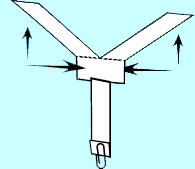|

Make three Roto-Copters for each person. Use a marker to
draw a 1-foot circle on a piece of newspaper. Put a cereal bowl in the middle
of the circle. The circle is the target area and the bowl is the bull's-eye.
Take turns standing on a chair at the edge of the newspaper and dropping
your Roto-Copters. At the Exploratorium, we get 3 points for a bull's-eye,
2 points for a copter inside the circle, and one point for just hitting
the newspaper-but you can make up any rules you want.
---------------------------------

Igor Sikorsky designed the first successful helicopter
in the late 1930s. His inspiration came from drawings of an aircraft with
a spinning wing, drawn by Leonardo da Vinci nearly five hundred years before.

Igor I.
Sikorsky Historical Archives
-Lots of photographs
and information about helicopters and the man who invented them.
Leonardo
da Vinci Museum
-This online gallery displays images and other information
related to Leonardo da Vinci. The "
West
Wing
" of the gallery has images of helicopters and other flying
machines.
We would like to hear about your results and discoveries. Please
send an email message to
Ken
Finn
.


©1997
Exploratorium
|

Why does the Roto-Copter spin?
When the Roto-Copter falls, air pushes up against the blades,
bending them up just a little. When air pushes upward on the slanted blade,
some of that thrust becomes a sideways, or horizontal, push.
Why doesn't the copter simply move sideways through the
air? That's because there are two blades, each getting the same push, but
in opposite directions. The two opposing thrusts work together to cause
the toy to spin.

Next time you drop your copter, notice which direction
it spins as it falls. Is it clockwise or counterclockwise? Now bend the
blades in opposite directions-if blade A was bent toward you and blade B
was bent away, bend B toward you and A away. Drop the copter again. Now
which way does it spin?
In the Spinning Blimp, air pushes up on the flat sides
of the strip of paper. When the flat side of the paper strip is parallel
to the ground, the blimp drifts down like a flat piece of paper. But if
the blimp tilts so that the flat side of the strip is at an angle to the
ground, the paper strip gets a sideways push, just like the blade of the
copter, sending the blimp spinning. Each time the flat strip comes around,
it gets another push and goes for another spin.
|